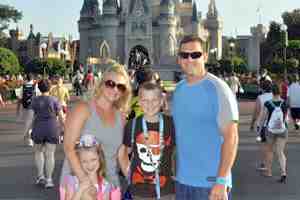Subscribe Now: 1 Full Year of WDW For Only $24.97!
Get full access to the WDW Crowd Calendar, Lines Mobile App, Touring Plans and More!

"Our TouringPlans subscription was a lifesaver on our trip. One of the busiest days of the year, and we never waited longer than 20 minutes!"
- Smith Family, KY
This palm-lined thoroughfare re-creates Tinseltown’s main drag during the Golden Age of Hollywood. Most service facilities are here, interspersed with eateries and shops. Merchandise includes Disney trademark items and movie-related souvenirs.
Hollywood characters and roving performers entertain on the boulevard, and other happenings pass this way.
Attractions
Also in Hollywood Boulevard...
In 1989, Michael Eisner proclaimed that Walt Disney World's third park would be dedicated to Hollywood "not a place on a map, but a state of mind" and "a Hollywood that never was, and always will be."
Inspired by early filmmakers who used Los Angeles as the background for their movies, Disney's Imagineers use real building facades and billboards to tell the story of the mythical Hollywood of our collective consciousness. For the architecture, the Imagineers apply a design trick called "shrink and edit" that takes a real building for inspiration and then changes the scale, color or detail to support the story. Hollywood Boulevard is filled with such examples.
You adventure starts at the park entrance as you pass through a reproduction of the Streamline Moderne Pan-Pacific Auditorium, Hollywood's primary convention center from 1935 to 1972. The entry plaza is at the intersection of Hollywood and Prospect Avenue. The central building is the Crossroad building (1936), which is a tribute to an early Los Angeles mini-mall. It is topped by a five-foot Mickey Mouse, with one of Mickey's ear's functioning as a lightning rod.
To the left of the park entrance is Sid Cahuenga's One-of-a-Kind shop, an example of the California Bungalow and inspired by the true story of the Janes House, in which a homeowner on Hollywood Boulevard held out against commercial development and a shopping mall just built around him. Other buildings include an electric substation (1907) from Culver City that is now a performance space, the Blaine Building (1926), a J.J. Newberry (1928), a bank on Wilshire Boulevard (1929), the Chapman Market (1929), Max Factor Building (1931), Owl Drug Store (1933), the Darkroom (1938), and many, many others. A highlight is The Hollywood Brown Derby (1929), which is a treasure inside and out.
The two billboards at the entrance establish the architectural timeframe for Hollywood and Sunset Boulevards as well as Echo Lake (1923-1945). The Hollywoodland billboard refers to a subdivision that opened in 1923, the same the year Walt Disney moved to Hollywood. Adjacent is a billboard for the 1945 Hollywood Canteen, a Hollywood oasis for soldiers fighting in World War II.
Dining
- DHS Hub Popcorn Cart (Food Stand or Cart)
- Hollywood Junction Bar Cart (Food Stand or Cart)
- Hollywood Junction Ice Cream and Snacks (Food Stand or Cart)
- Hot and Fresh Popcorn - Near Runaway Railway (Food Stand or Cart)
- Hot and Fresh Popcorn - Near Tip Board (Food Stand or Cart)
- Ice Cold Stand (Food Stand or Cart)
- Peevy's Polar Pipeline (Food Stand or Cart)
- Pretzel and Ice Cream Stand (Food Stand or Cart)
- Runaway Railway Ice Cream Cart (Food Stand or Cart)
- The Hollywood Brown Derby (Table Service)
- The Hollywood Brown Derby Lounge (Bar or Lounge)
- The Trolley Car Café (Quick Service)

